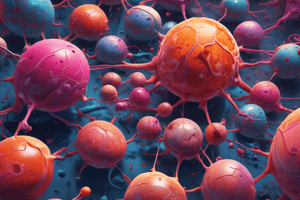Podcast
Questions and Answers
What distinguishes dry gangrene from other types of necrosis?
What distinguishes dry gangrene from other types of necrosis?
- Involves extensive cellular inflammation
- Characterized by apoptotic bodies
- Presence of liquefactive necrosis
- Only coagulative necrosis is observed (correct)
Which change is NOT typically seen in necrosis?
Which change is NOT typically seen in necrosis?
- Nuclear shrinkage
- Fragmentation of the nucleus
- Leukocyte apoptosis (correct)
- Increased eosinophilia
Which process is characterized by the removal of individual cells without causing inflammation?
Which process is characterized by the removal of individual cells without causing inflammation?
- Cellular decay
- Necrosis
- Apoptosis (correct)
- Infarction
What feature is a characteristic of apoptosis?
What feature is a characteristic of apoptosis?
What morphological change occurs in the nucleus during pyknosis?
What morphological change occurs in the nucleus during pyknosis?
What is the main difference between necrosis and apoptosis?
What is the main difference between necrosis and apoptosis?
Which of the following is NOT a cause of necrosis?
Which of the following is NOT a cause of necrosis?
What type of necrosis is characterized by a cheese-like appearance?
What type of necrosis is characterized by a cheese-like appearance?
Which type of necrosis is primarily associated with bacterial infections that lead to pus formation?
Which type of necrosis is primarily associated with bacterial infections that lead to pus formation?
Which mechanism can lead to cell injury in necrosis?
Which mechanism can lead to cell injury in necrosis?
Gangrenous necrosis primarily occurs due to which condition?
Gangrenous necrosis primarily occurs due to which condition?
What term describes the diminished blood flow to a tissue that can result in acute cell injury?
What term describes the diminished blood flow to a tissue that can result in acute cell injury?
Fat necrosis is most commonly caused by damage to what type of tissue?
Fat necrosis is most commonly caused by damage to what type of tissue?
Flashcards
Necrosis
Necrosis
Cell death with loss of membrane integrity and leakage of cellular content, often due to enzyme damage to injured cells.
Morphology of Necrosis
Morphology of Necrosis
Necrotic cells reveal changes, including increased pink staining (eosinophilia) and altered/broken-down nuclei.
Apoptosis
Apoptosis
Programmed cell death of individual cells, typically within a larger group of cells, without inflammation.
Apoptotic Changes
Apoptotic Changes
Signup and view all the flashcards
Dry Gangrene
Dry Gangrene
Signup and view all the flashcards
Pathology Definition
Pathology Definition
Signup and view all the flashcards
Necrosis Causes
Necrosis Causes
Signup and view all the flashcards
Coagulative Necrosis
Coagulative Necrosis
Signup and view all the flashcards
Liquefactive Necrosis
Liquefactive Necrosis
Signup and view all the flashcards
Gangrenous Necrosis
Gangrenous Necrosis
Signup and view all the flashcards
Causes of Cell Injury
Causes of Cell Injury
Signup and view all the flashcards
Study Notes
Definition of Pathology
- Pathology is the scientific study of disease.
- The word "pathology" comes from Latin words "patho" (disease) and "logy" (study).
Cell Death Types
- Cells can die in two ways: Necrosis and Apoptosis.
Necrosis Mechanisms
- In necrosis, excess fluid enters the cell, causing swelling and rupture of its membrane.
- Enzymes for cell digestion are derived from dying cells and leukocytes.
- Necrosis can be caused by:
- Hypoxia (lack of oxygen)
- Free radical-induced cell injury
- Cell membrane damage
- Increased intracellular calcium level
Causes of Cell Injury and Necrosis
- Ischemic and Hypoxic Injury: Reduced blood flow to a tissue.
- Chemical (Toxic) Injury: Exposure to harmful substances like mercury, often from contaminated food.
- Infectious Agents: Infections by viruses, bacteria, or fungi.
- Immunologic Reactions: Immune responses that damage tissues.
- Genetic Defects: Errors in cellular processes.
Types of Necrosis
- Coagulative Necrosis: Occurs due to sudden interruption in blood supply to an organ (especially heart).
- Liquefactive Necrosis: Tissue digestion and liquefaction, often seen in suppurative infections (pus formation).
- Fat Necrosis: Trauma to fatty tissues, such as the breast.
- Caseous Necrosis: Cheese-like appearance, often associated with tuberculosis.
- Gangrenous Necrosis: Vascular occlusion, often affecting lower extremities or bowel. Can be wet (liquefactive component) or dry (only coagulative component).
Necrosis Morphology
- Cytoplasmic changes: Increased eosinophilia (pink stain).
- Nuclear changes: Karyolysis (chromatin fading), Pyknosis (nuclear shrinkage), Karyorrhexis (fragmentation).
- Nucleus may completely disappear in 1-2 days.
Apoptosis
- Apoptosis is the death of individual cells within a cluster of other cells.
- Necrosis leads to cellular cluster death.
- Features of apoptosis include:
- Cell shrinkage
- Acidophilic staining
- Fragmentation into apoptotic bodies
- Apoptosis is a normal process for tissue remodeling during development and other physiological processes. Can also occur in response to mild injury.
- Apoptosis is not followed by inflammation or calcification.
Apoptosis Morphology
- Apoptotic cells have fragmented nuclei with condensed chromatin and shrunken cell bodies.
Studying That Suits You
Use AI to generate personalized quizzes and flashcards to suit your learning preferences.




